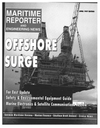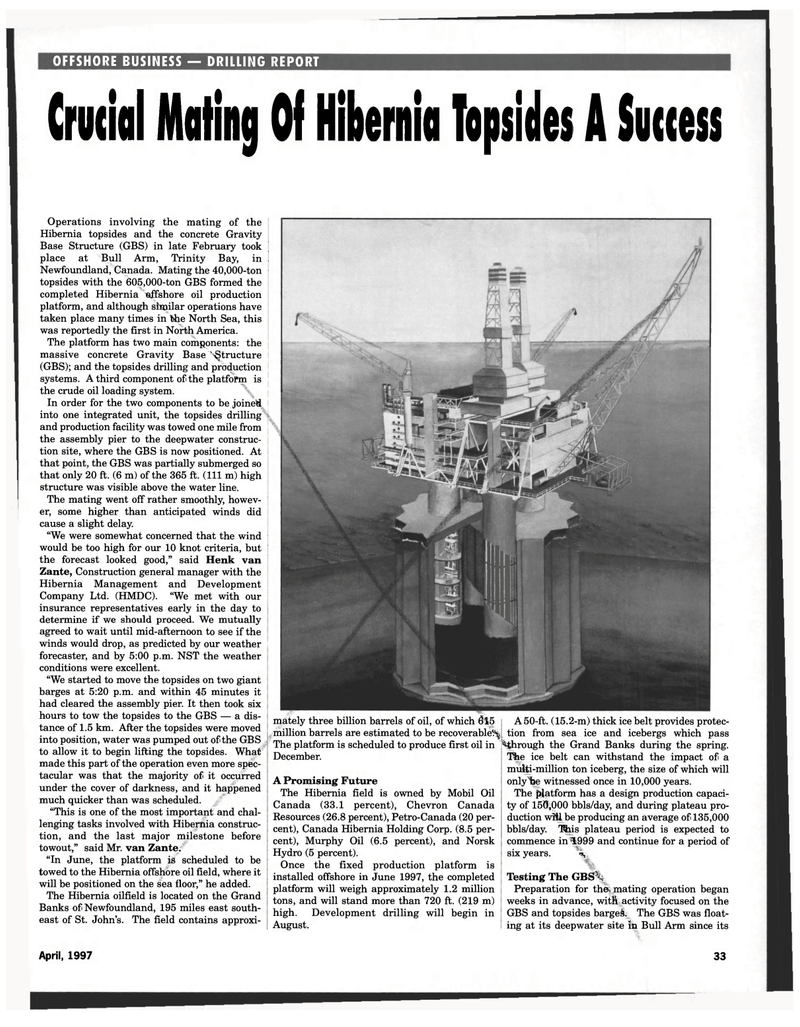
Page 33: of Maritime Reporter Magazine (April 1997)
Read this page in Pdf, Flash or Html5 edition of April 1997 Maritime Reporter Magazine
OFFSHORE BUSINESS — DRILLING REPORT
Crucial Mating Of Hibernia Topsides A Success
A 50-ft. (15.2-m) thick ice belt provides protec- tion from sea ice and icebergs which pass ^through the Grand Banks during the spring.
The ice belt can withstand the impact of a multi-million ton iceberg, the size of which will only be witnessed once in 10,000 years.
The platform has a design production capaci- ty of 150,000 bbls/day, and during plateau pro- duction will be producing an average of 135,000 bbls/day. This plateau period is expected to commence in 1999 and continue for a period of six years. >,
Testing The GBSPk
Preparation for the mating operation began weeks in advance, with activity focused on the
GBS and topsides barged. The GBS was float- ing at its deepwater site in Bull Arm since its
Operations involving the mating of the
Hibernia topsides and the concrete Gravity
Base Structure (GBS) in late February took place at Bull Arm, Trinity Bay, in
Newfoundland, Canada. Mating the 40,000-ton topsides with the 605,000-ton GBS formed the completed Hibernia offshore oil production platform, and although similar operations have taken place many times in the North Sea, this was reportedly the first in North America.
The platform has two main components: the massive concrete Gravity Base Structure (GBS); and the topsides drilling and production systems. A third component of the platform is the crude oil loading system.
In order for the two components to be joined into one integrated unit, the topsides drilling and production facility was towed one mile from the assembly pier to the deepwater construc- tion site, where the GBS is now positioned. At that point, the GBS was partially submerged so that only 20 ft. (6 m) of the 365 ft. (Ill m) high structure was visible above the water line.
The mating went off rather smoothly, howev- er, some higher than anticipated winds did cause a slight delay. "We were somewhat concerned that the wind would be too high for our 10 knot criteria, but the forecast looked good," said Henk van
Zante, Construction general manager with the
Hibernia Management and Development
Company Ltd. (HMDC). "We met with our insurance representatives early in the day to determine if we should proceed. We mutually agreed to wait until mid-afternoon to see if the winds would drop, as predicted by our weather forecaster, and by 5:00 p.m. NST the weather conditions were excellent. "We started to move the topsides on two giant barges at 5:20 p.m. and within 45 minutes it had cleared the assembly pier. It then took six hours to tow the topsides to the GBS — a dis- tance of 1.5 km. After the topsides were moved into position, water was pumped out of the GBS to allow it to begin lifting the topsides. What made this part of the operation even more spec- tacular was that the majority of it occurred under the cover of darkness, and it happened much quicker than was scheduled. "This is one of the most important and chal- lenging tasks involved with Hibernia construc- tion, and the last major milestone before towout," said Mr. van Zante. "In June, the platform is scheduled to be towed to the Hibernia offshore oil field, where it will be positioned on the sea floor," he added.
The Hibernia oilfield is located on the Grand
Banks of Newfoundland, 195 miles east south- east of St. John's. The field contains approxi- mately three billion barrels of oil, of which 615 million barrels are estimated to be recoverable?^
The platform is scheduled to produce first oil in
December.
A Promising Future
The Hibernia field is owned by Mobil Oil
Canada (33.1 percent), Chevron Canada
Resources (26.8 percent), Petro-Canada (20 per- cent), Canada Hibernia Holding Corp. (8.5 per- cent), Murphy Oil (6.5 percent), and Norsk
Hydro (5 percent).
Once the fixed production platform is installed offshore in June 1997, the completed platform will weigh approximately 1.2 million tons, and will stand more than 720 ft. (219 m) high. Development drilling will begin in
August.
April, 1997 33

 32
32

 34
34
